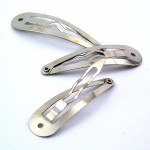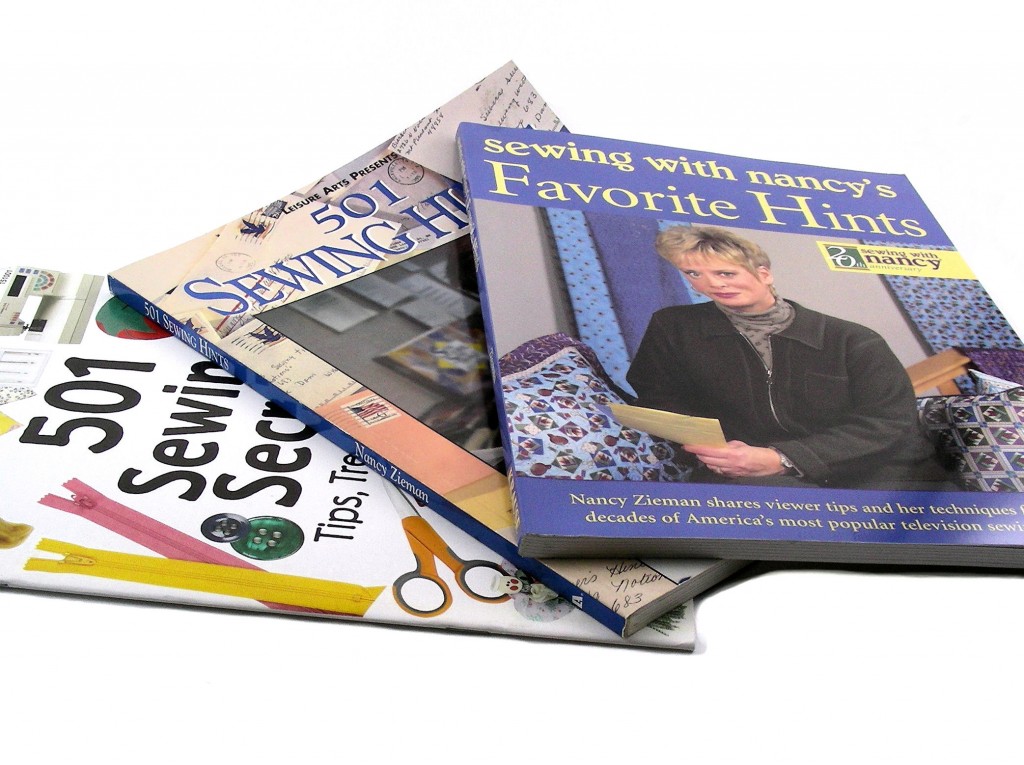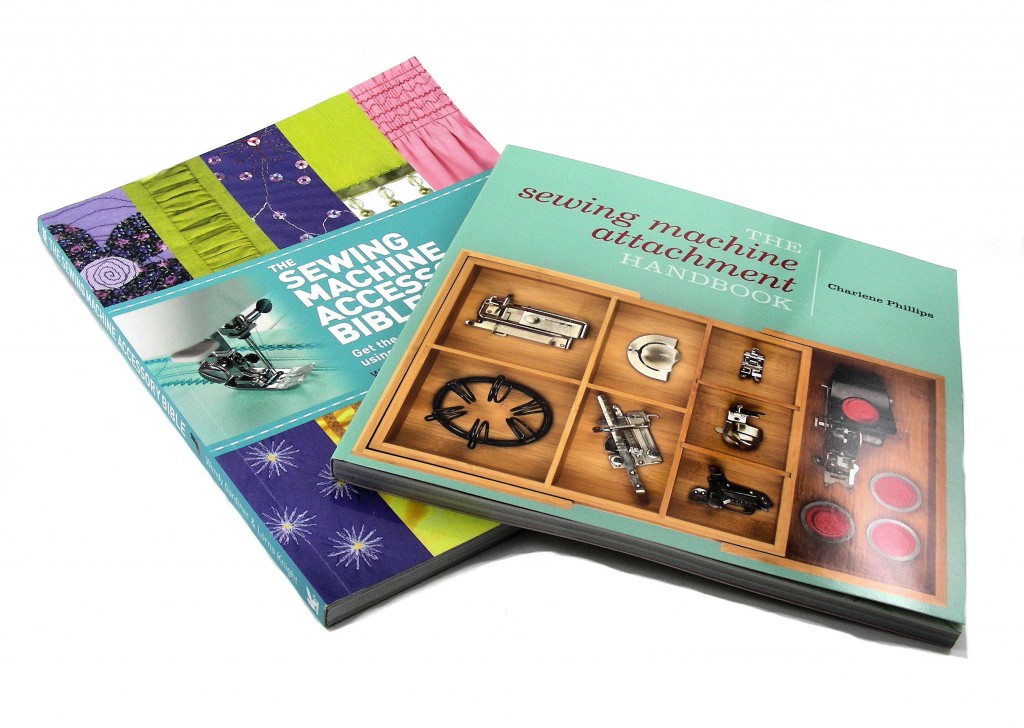I was looking at my sewing bookshelf recently and realized I have many books geared toward making sewing easier. There is quite a market, in fact, for books containing tips that mothers of yesteryear passed on to their daughters, or for advice about so-called modern sewing techniques. Staring at me in the face are some older-but-still-relevant titles, such as 501 Sewing Secrets: Tips, Treasures & Trivia, 501 Sewing Hints: From the Viewers of Sewing with Nancy, and Sewing with Nancy’s Favorite Hints.
Don’t even get me started on the list of books that tout sewing notions! But here’s one book that is really good, and yes, it will put a dent in your pocketbook (the notions, not the book!):
If you own a sewing machine, you’ll get more use out of it if you know how to use its attachments. But just in case you don’t have enough of those, you can learn about others through The Sewing Machine Attachment Handbook and The Sewing Machine Accessory Bible.
Seriously—all joking aside—these books are useful, especially if you read them before you start doing things the hard way. Did you notice, however, how quickly you can spend a small fortune on sewing notions and accessories?
While I was eating dinner the other night, my conversation with my husband revolved around ordinary household objects you can use in the sewing room instead of purchased gadgets. Okay, I’ll be honest here—I talked, and John listened. But here is the list of time-saving (and inexpensive) items most people have in their homes to accomplish tasks for which special sewing notions have been designed.
- To clean the sole plate of your iron, just heat your iron and run it over a piece of wax paper. Fold the wax paper, and repeat as necessary.
- Need tracing paper? Use wax paper. You can fuse the sheets together with a heated iron if you need your paper to be wider.
- It’s not necessary to buy a spool holder for cone or specialty thread. Just drop your spool in a coffee mug behind your sewing machine, and thread your machine.
- The fastest way to pin a pattern to fabric is to use fabric weights. But don’t buy them; use soup cans.
- Transparent tape is an excellent straight seam guide, especially when you insert a zipper. Just adhere the tape to your fabric.
- Need to cut a curved edge? Use a dinner plate and your rotary cutter.
- You don’t need a cording foot to guide a cord beneath the sewing machine needle. Just tape part of a drinking straw to your sewing table, and feed the cord through the tube.
- Curved hair clips are excellent to use as hemming pins.

- Don’t have a hem gauge? Just cut a strip of manila file folder the depth of your hem, fold over your fabric, insert the manila file folder strip, and iron away.
- Clear nail polish, brushed onto the ends of ribbon, is a great fray check. Once upon a time, that’s how we ladies stopped the runs in our pantyhose.
- Clean out the lint from your bobbin case with a small cosmetic brush or even an ear swab. It works much better than the stiff brush that comes with your sewing machine, or the one you can buy at the fabric store.
- A narrow strip of paper cut from a folded sticky note or index card is an inexpensive and readily available threader for yarn or decorative threads. Obviously, use a needle with a larger eye.
- Use a wooden kebab skewer to poke out fabric corners.
- Can’t find your tracing wheel? Who cares? Draw pattern symbols on mailing labels, cut them out and adhere them in place. Or just use old-fashioned tailor’s tacks—stitch a loose X in place by hand.
- Paper clips work well as emergency pins. Color code them for pattern notches or other pattern symbols.
- If you don’t have a fabric tube turner, just push the outside end of the tube to the inside with a closed safety pin, a bobby pin, a wooden kebab skewer, or even a pencil, if the tube is wide enough.
- A quick-and-easy stitching guide is a stack of sticky notes. Just adhere the pad to your sewing machine bed where you want your stitching line to be, and push the fabric up against it.
- If you are couching multiple threads in place and need to keep them separated, tape a plastic fork or comb perpendicular to the edge of your table, and just run the threads through the tines. Keep the balls or spools in coffee mugs on the floor!
- A balloon is a great needle grabber when you can’t pull the needle through the fabric.
- Don’t have a Hera marker? Just use the blunt side of a butter knife.
- You’re sewing a shoulder seam and you don’t have any stabilizer tape. Just sew over a length of fabric selvedge. It doesn’t ravel or stretch.
- If you need a temporary, raised seam guide, just slide a rubber band over the free arm of your sewing machine where the stitching line is supposed to be.
- If you need a vertical spool holder, insert a wooden dowel or Tinker Toys rod in a recessed hole that is often a part of your sewing machine.
- A temporary but effective ironing board is a cotton bath towel, folded to the desired thickness.
Here are 6 sewing tips that will save you time in the long run:
- Instead of stitching two parallel lines in preparation for fabric gathering, just sew a wide zig-zig stitch over buttonhole thread.
- Save your vacuum cleaner: keep a lint or pet roller near your sewing machine to pick up not only threads but also runaway pins.
- You’ll spend less time re-fusing interfacing to fabric if you heat up the fabric first. It creates a better bond.
- Spend less time analyzing which is the wrong side of your fabric by simply marking it with tape.
- Hang fabric pieces on hangers between sewing sessions to keep them out of the way.
- Need to cut out the same shape again and again? Trace it onto freezer paper, cut out the shape, and fuse it into place using your iron. Cut out your shape, peel off the freezer paper, and re-fuse as a tracing shape as many times as you need.
For more ideas, you can buy the books I described above . . . or read the comments from the readers of this post. Add your own alternate sewing notion ideas or time-saving sewing tips below.
Mental health disclaimer: I’m a gadget junkie, and own more sewing notions and sewing machine attachments than I can count.
© 2013 Judy Nolan. All rights reserved.




You have some brilliant ideas in this post, some I knew and some I didn’t.
I like the idea of the soup cans. I don’t understand about the balloon.
Great tips and useful tools! I have a lot of sewing books etc. too.
My blog contains some tips and tricks I find useful, I love to come up with different ways to use simple ordinary items as tools. Here is a sample from my blog:
http://therosejournal.blogspot.com/2010/07/rosies-monday-night-tidbits.html
Great post! I’m definitely going to use a Q-Tip next time I clean my bobbin case, and using the back side of a knife as a Hera marker is a great idea!
I’m a big Sewing With Nancy fan, too. I’m a quilt show junkie, starting years ago with Georgia Bonesteel, Eleanor Burns, Fons & Porter, Simply Quilts, America Sews, Sewing With Nancy, and Quilting Arts with Pokey Bolton.
Thanks for putting together this great resource!
What cool ideas!! My mom would love this (and those books). I need to use that iron cleaning tip right about now!
I don’t sew a ton of things, but it’s something I mean to do more often. Thanks for all of the tips! You just saved me some headaches.
Soup cans!! Aren’t you clever!
I remember the days of clear nail polish and pantyhose!!
I rarely sew anymore but have used a number of these hints — I must admit, though, to having and using a hem gauge!
Great list of tips! It’s always nice to learn a new technique that makes crafting easier and more fun 🙂
What a big list! #3 is very clever.